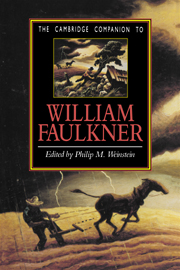2 - Faulkner and Postmodernism
from Part I - The Texts in the World
Published online by Cambridge University Press: 28 May 2006
Summary
Faulkner’s “modernism” has often been the subject of spirited discussion about the author’s intrusion on, or complicity with, the monumental literature of the twentieth century. To think of Faulkner within the terms of “postmodernism,” then, necessarily involves an attempt to define the relation of modernism to postmodernism. This relation can only be seen coming in the wake of Faulkner’s fiction, as a kind of critical aftermath that allows us to see it as differentiated from the contexts in which it was written and by which it is constrained. In essence, discussing Faulkner in postmodernist terms means accepting the assumption that what makes his fiction powerful and timely is its capacity to resist, disrupt, or exceed both Modernism (with a capital “M”) and Faulkner’s own modernism - his intended response to the perceived literary, cultural, and historical contexts of his writing. Within the discussion of Faulkner and postmodernism, Faulkner stands not as the "author" or progenitor of texts but, to employ the famous metaphor articulated by Quentin Compson in Absalom, Absalom!, as the unseen drop that falls into a pool of water, giving rise to a series of ripples that move outward to another connected pool: "let this second pool contain a different temperature of water, a different molecularity of having seen, felt, remembered, reflect in a different tone the infinite unchanging sky, it doesn’t matter: that pebble’s watery echo whose fall it did not even see moves across its surface too at the original ripple-space" (210).
- Type
- Chapter
- Information
- The Cambridge Companion to William Faulkner , pp. 31 - 50Publisher: Cambridge University PressPrint publication year: 1995



